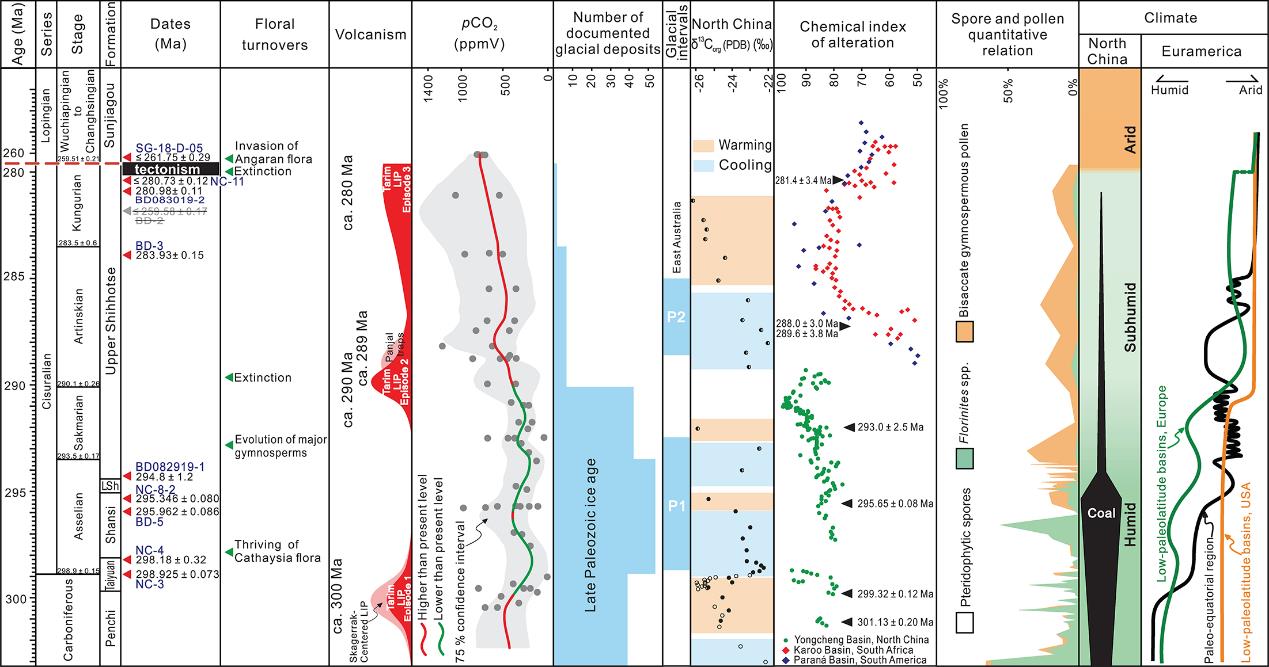The study provides a fundamental revisions to the traditional Permian terrestrial depositional history and chronostratigraphy of the North China block, and provide a new timeline and important insights for the history of continental collision, floral turnovers, and paleoclimate change as recorded in the North China block.
The North China block occupied northerly tropical to subtropical paleolatitudes, marginal to the Paleo-Asian Ocean (PAO), during the critical Cisuralian (298.9-273.0 Ma) transitions from an icehouse to a greenhouse world. The late Carboniferous to Permian marine and marginal-marine to terrestrial sequences in North China preserve highly diverse and abundant plant fossils in addition to their significant economic hydrocarbon resources. These characteristics provide a unique opportunity to investigate the interactions among terrestrial biotic evolution, regional tectonics, and global climate change during a critical period of geologic history.
However, poor constraints on age and correlation have hampered a deep understanding of those events in the North China block. In the absence of diagnostic marine fossils from key intervals, stratigraphic correlation within and beyond North China has relied on uncalibrated palynostratigraphy and phytostratigraphy and magnetostratigraphy. Detrital zircon geochronology by U-Pb in situ analyses from Permian volcaniclastic sandstones generally lacked the necessary precision or stratigraphic range to place reliable constraints on depositional ages.
Recently, the Late Paleozoic research group from Nanjing Institute of Geology and Palaeontology, Chinese Academy of Sciences (NIGPAS), Nanjing University and other researchers from China, USA and Canada, report high-precision U-Pb zircon geochronology by the chemical abrasion–isotope dilution–thermal ionization mass spectrometry (CA-ID-TIMS) method focused on bentonitic tuffs from the Permian succession in North China. New high-precision U-Pb geochronology necessitates major revisions to the temporal framework for the Permian terrestrial system in North China. The research results were recently published in the international academic journal Geology.
The Upper Shihhotse Formation spans the latest Asselian to the early Kungurian, as opposed to its previous Wordian to Wuchiapingian age assignments. A major depositional gap during the late Cisuralian to Guadalupian in the northern North China block may have been caused by convergent tectonics associated with the closure and/or subduction of the PAO.
The great loss of highly diverse and abundant Cathaysian floras and the widespread invasion of the Angaran floras under arid climate conditions in the North China block happened during the late Cisuralian to Guadalupian, but its exact timing is uncertain due to the long hiatus. The Cisuralian global aridification may have been associated with extensive LIP volcanism and the rise of atmospheric CO2 in the waning stages of the LPIA.
The research was supported by the Strategic Priority Research Programs (B) of the Chinese Academy of Sciences.
Reference: Q. Wu, J. Ramezani, H. Zhang*, J. Wang, F. Zeng, Y. Zhang, F. Liu, J. Chen, Y. Cai, Z. Hou, C. Liu, W. Yang, C. M. Henderson, S. Shen*,2021, High-precision U-Pb age constraints on the Permian floral turnovers, paleoclimate change and tectonics of North China. Geology 49, 677–681.https://doi.org/10.1130/G48051.1

Figure 1. Compilation of Permian global events in parallel with Earth system changes in the North China block.
Contact:
LIU Yun, Propagandist
Email: yunliu@nigpas.ac.cn
Nanjing Institute of Geology and Palaeontology, Chinese Academy of Sciences
Nanjing, Jiangsu 210008, China
Download:
